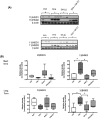Harnessing the gatekeepers of glucocorticoids for chemoprevention of non-melanoma skin cancer
- PMID: 30302860
- PMCID: PMC6563487
- DOI: 10.1002/mc.22912
Harnessing the gatekeepers of glucocorticoids for chemoprevention of non-melanoma skin cancer
Abstract
Despite effective surgical methods for non-melanoma skin cancer (NMSC), patients suffer from tissue damage, scarring, or even disfigurement; thus, there is a need for chemopreventive approaches. Because of the complex interplay between glucocorticoids (GCs), inflammation, and cancer, we sought to determine the role of 11β-hydroxysteroid dehydrogenase 1 and 2 (11βHSD1 and 2) in regulating GCs during skin cancer development and progression. 11βHSDs modulate the activation of GCs in a tissue-specific manner and have been reported to play a role in development and progression of other types of cancer, but their role has not yet been reported in NMSC. Here, we found a significant upregulation of 11βHSD2 protein in skin cancer cells when compared to normal skin cells, suggesting a role for this enzyme in the multifactorial process of skin cancer development. In addition, inhibition of 11βHSD2 with siRNA resulted in significant reduction in colony formation in vitro. Finally, our in vivo study elucidated that inhibition of 11βHSD2 with pharmacological inhibitor, Glycyrrhetinic acid (GA) could significantly diminish tumorigenesis in a well-studied in vivo mouse model of NMSC. Overall, these studies highlight for the first time a potential novel role for 11βHSD2 in NMSC development and may allow for new GC treatment approaches capable of avoiding deactivation by the enzyme. If 11βHSD2 can be inhibited as we have done here, or circumvented using modified GCs, this may lead to more efficacious outcomes for NMSC patients by preventing deactivation of the GC and minimizing resistance.
Keywords: 11β-hydroxysteroid dehydrogenases; chemoprevention; glucocorticoids; glycyrrhetinic acid; non-melanoma skin cancer; phytochemicals.
© 2018 Wiley Periodicals, Inc.
Conflict of interest statement
The authors declare that they have no conflict of interest.
Figures





References
-
- Eisemann N, Waldmann A, Geller AC, et al. Non‐melanoma skin cancer incidence and impact of skin cancer screening on incidence. J Invest Dermatol. 2014;134:43–50. - PubMed
-
- Schulze HJ, Cribier B, Requena L, et al. Imiquimod 5% cream for the treatment of superficial basal cell carcinoma: results from a randomized vehicle‐controlled phase III study in Europe. Br J Dermatol. 2005;152:939–947. - PubMed
Publication types
MeSH terms
Substances
Grants and funding
LinkOut - more resources
Full Text Sources
Medical
Miscellaneous

